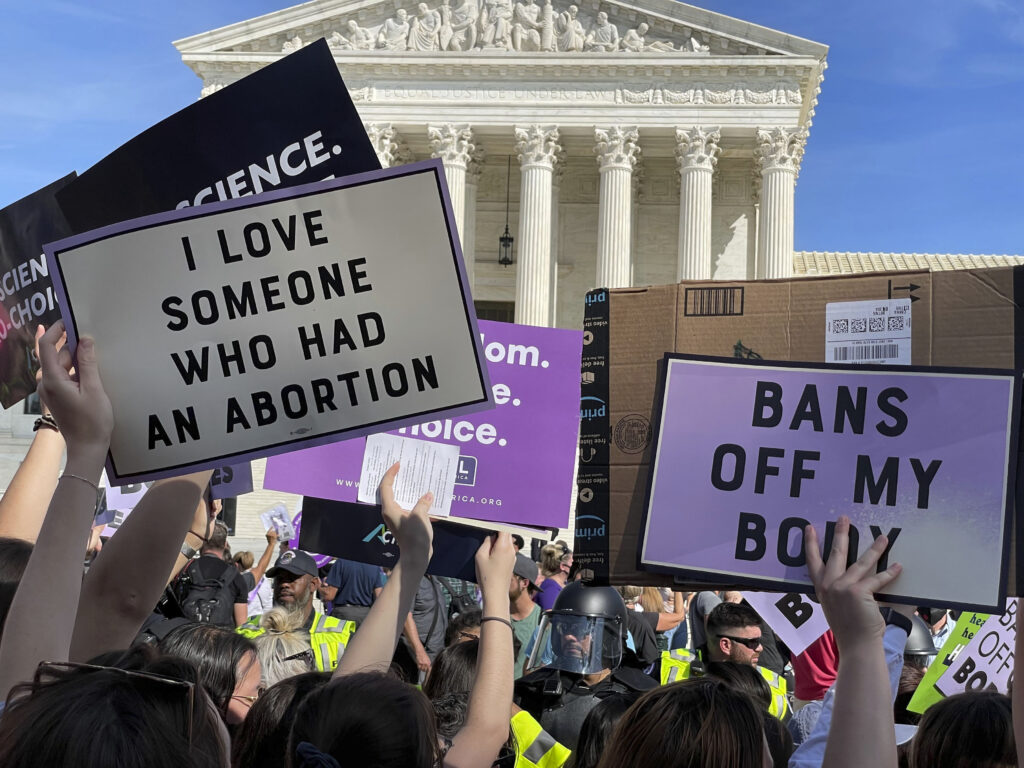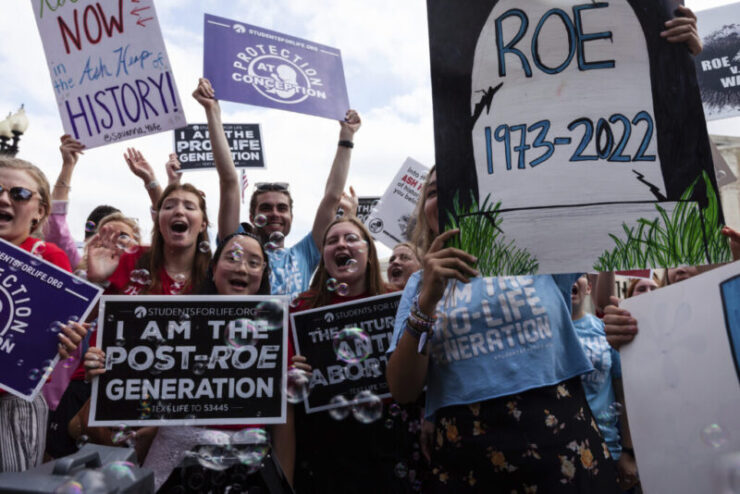The beginning of the end of government by judiciary.
We have just experienced the most important term of the United States Supreme Court in the last 49 years.
In 1973, in Roe v. Wade, the Court found somewhere in “penumbras and emanations” from various constitutional provisions a “right to privacy” capacious enough to allow a woman to terminate a pregnancy any time before fetal viability. This year, in Dobbs v. Jackson Women’s Health Organization, four justices of the Supreme Court—Clarence Thomas, Neil Gorsuch, Brett Kavanaugh, and Amy Coney Barrett—joined in a majority opinion by Justice Samuel Alito, which stated flatly that there was no constitutional warrant for Roe or for any of its progeny, such as Planned Parenthood v. Casey (1992), a decision that reaffirmed Roe 19 years later. In pellucid prose, Justice Alito wrote, “The Constitution makes no reference to abortion, and no such right is implicitly protected by any constitutional provision.”
The overruling of Roe is the greatest triumph to date of the conservative legal movement, and the language of Alito’s opinion echoes the thought of Antonin Scalia, who, dissenting in Casey, made clear his view that the Supreme Court had no business making abortion policy, that it did itself and the country no service by struggling to provide ever-changing, ever-more-specific, and increasingly incomprehensible abortion regulations.
Roe was the unhappy culmination of a process that is probably traceable to the man regarded as the only “authentic sage” of American law, Supreme Court Justice Oliver Wendell Holmes, Jr., who had written in 1881 that “the life of the law has not been logic, but experience.” This deceptively simple statement had implications that the business of judges was not to follow the rules laid down but rather to refashion them so as to suit the changing needs of the times. It was, in effect, a warrant for judges to act as legislators rather than adjudicators.
A philosophy of law, regarded as uniquely American “legal realism,” soon emerged in books by admirers of Holmes, such as Jerome Frank’s Law and the Modern Mind (1930). Frank, an ardent New Dealer, praised Holmes as the nation’s only “adult jurist” and urged lawyers, law students, and judges to get about the business of cashiering mindless old legal doctrines and rules so as to replace them with new judicial creations fit for a more democratic and dynamic polity. Once Franklin Roosevelt had succeeded in nominating and confirming enough justices sympathetic to New Deal policies, that is precisely what the Supreme Court did.
Meanwhile, Frank’s and Holmes’s thought—promoted at such bastions of establishment authority as the law schools of Yale, Columbia, and Harvard—soon swept the legal academy. The ultimate triumph of legal realism was achieved most notably by the Warren Court, when Chief Justice Earl Warren persuaded his fellows to reexamine school segregation, criminal procedure, legislative apportionment, public-school prayer and Bible reading, and a host of other social issues.
It is a considerable understatement to suggest that the Supreme Court had become the country’s super-legislature, and Roe, a 7-2 decision of the Warren Burger court, was the culmination of this trend. Not for nothing, then, did attorney Raoul Berger (no relation to Chief Justice Warren Burger) lament in his aptly titled and important book, Government by Judiciary (1977), that we were suffering under the loss of self-government.
A few conservative voices like Berger’s, including those who wrote in the pages of this magazine, protested the Court’s jurisprudence. But because the Warren Court’s egalitarian and Wilsonian progressive ideology was dominant in the universities, in their law schools, and in the national media, and because Roe could be painted as a triumph of feminist ideology, purportedly giving women more freedom to structure their lives and careers, Roe became, in the words of some politicians, a “super-duper” precedent—one that must never be overruled.
Still, there were at least three nagging problems with Roe that troubled honest observers.
The first was the most obvious, that Roe was not simply a case about the rights of women; it was a case that involved the authorization of the termination of what the Supreme Court gingerly called a “potential human life,” and what pro-life advocates passionately and correctly argued was a person, entitled to constitutional protection.
Second was the extraordinary shoddiness of the legal reasoning in Roe, since the Constitution said nothing about abortion and since matters of family law had traditionally and constitutionally been handled by state and local governments, not federal officials.
Third was that Roe, in its arbitrariness, was an act not only of judicial legislation but of judicial tyranny. The Court was functioning in unauthorized territory, not only—as some would say—condoning the taking of human life but also usurping the right of the American people to govern themselves. In one of the most impressive passages of his most impressive Dobbs opinion, Justice Alito noted, quoting Scalia’s dissent in Casey, “It is time to heed the Constitution and return the issue of abortion to the people’s elected representatives. ‘The permissibility of abortion, and the limitations, upon it, are to be resolved like most important questions in our democracy: by citizens trying to persuade one another and then voting.’ That is what the Constitution and the rule of law demand.” And so it is!
The reaction to Dobbs has been galvanic. One could have anticipated that the progressives in the media and the academy, as well as the liberal justices dissenting in Dobbs, would rail at the majority for taking away the rights of women (although, of course, it was Roe that manufactured a nonexistent right). But somewhat surprising was the hostility directed at the Court itself because of the possibility that this new turn in constitutional jurisprudence would put at risk other “rights” previously asserted by way of judicial inference from the Constitution.
Singled out for excoriation was the senior Associate Justice Clarence Thomas, who may well be the justice most faithful to the original understanding of the Constitution. Thomas began his concurring opinion in Dobbs with his signature honesty, fearlessness, and bravado as he noted, with regard to the logic of Roe’s defenders, that “the idea that the Framers of the Fourteenth Amendment understood the Due Process Clause to protect a right to abortion is farcical.”
In further language terrifying to progressives, Thomas went on to ridicule the “substantive due process” notion that was invoked to justify Roe. According to this exceptionally dubious doctrine, as Thomas explained, the Court was wont to suggest that there were some rights so fundamental that any procedures used to abridge them were somehow not “due process.”
Just what those rights were was never clearly revealed—only that they were “fundamental” and deeply rooted in our history and our historic liberties. To suggest abortion was one of these rights was indeed farcical, but Thomas, quite properly calling the doctrine of “substantive due process” an oxymoron, wrote in his concurring opinion in Dobbs that the Court’s earlier substantive due process cases should be reviewed after Roe’s overturn. Included in such a review would be cases that forbid prohibitions on the sale of contraceptives to adults, cases that forbid the criminalization of consensual homosexual sodomy, and cases that demand the permissibility of same-sex marriage—all of these ought to be reexamined by the Court, Thomas argued. He was, of course, correct, because the real implication of Dobbs is that with Roe, the Supreme Court lost its way and needed a course correction.
To be sure, Thomas indicated that some of the rights the Court had spun out of the whole cloth of substantive due process might actually be protected by the Fourteenth Amendment’s rather obscure “privileges and immunities” clause: “No State shall make or enforce any law which shall abridge the privileges or immunities of citizens of the United States.” But the task of proving those rights in the Court remains to be undertaken.

Two other failings of the Supreme Court were also addressed this term. One was the Court’s execrable “establishment clause” jurisprudence, which, in some of its most reprehensible cases, read the First Amendment’s admonition that “Congress shall make no law regarding an establishment of religion” as a general prohibition on any government endorsement of religion at all.
The original establishment clause was actually a federalist provision that reserved policy-making on religion to the state and local governments while barring the federal government from interfering. Read in context at the time of the American Revolution, the clause made good sense. Then there were several established state churches, and lingering qualifications for the franchise and office-holding turned on religious affiliation.
One can see clearly that the new Supreme Court conservative majority have emerged as the true defenders of democracy—or at least of constitutional government.
At that time, of course, John Adams could remark that our Constitution itself was fit only for a religious people, and in 1776, even the most radical state, Pennsylvania, required each officeholder to swear or affirm that he believed in a God who rewarded the just and punished the wicked.
To turn the establishment clause into a weapon for overturning religious policies of the state and local governments was a great perversion of constitutional law. The Supreme Court has yet to acknowledge the magnitude of its earlier error, but in two notable cases this term, the Court moved in that direction, first by indicating that benefits provided by the state of Maine to nonsectarian private schools had to be extended as well to religious private schools, and second by holding that a public school could not fire a coach who engaged in public prayer on the 50-yard line following football games. If the Court has not yet given a full-throated endorsement of John Adams’s views, it might still.

The other structural constitutional issue that the Court gingerly took steps toward correcting was the overweening federal bureaucracy, what academics call the “administrative state,” and what President Trump and others used to call the “deep state.” In the case West Virginia v. Environmental Protection Agency, the Court ruled that the EPA did not have the authority to implement a fossil-fuel regulatory scheme that had failed to pass Congress.
Thus, the Biden administration was not permitted to use a federal agency, through an expansive and dubious interpretation of its regulatory powers, to implement a policy that had failed to pass legislative muster. Several commentators believed that this was the most important case of the term, since its far-reaching implications offered some hope for taming the federal Leviathan. As Hugh Hewitt correctly observed in The Washington Post
The court’s ruling certainly was a setback for the “pen and phone” brigade of progressives who believe a progressive president ought to be able to use phone or email to order executive branch agencies to do whatever he or she determines is necessary and proper.
Most interesting in that case was a footnote in Justice Gorsuch’s concurring opinion. Gorsuch struck at the very foundation of progressive ideology by condemning the thoughts of its most prominent exponent, former Princeton University and United States President, Woodrow Wilson. Wilson, Gorsuch pointed out, “famously argued that ‘popular sovereignty’ ‘embarrasse[d]’ the Nation because it made it harder to achieve ‘executive expertness.’”
Continuing, Gorsuch made clear that the notion, “experts know best,” as exemplified by Wilson, implied that “the mass of the people were ‘selfish, ignorant, timid, stubborn, or foolish.’” The left is fond of painting itself as the party of “democracy,” but in Gorsuch’s footnote, one can see clearly that the new Supreme Court conservative majority have emerged as the true defenders of democracy—or at least of constitutional government.
One must not put one’s faith in “princes”—or judges—but those of us who believed that Donald Trump, if elected, would put the Supreme Court back on the path to
defending the Constitution have been vindicated.
Top image: Pro-life activists celebrate after the Supreme Court issued its opinion on Dobbs
(Allison Bailey / NurPhoto via Associated Press)

Leave a Reply